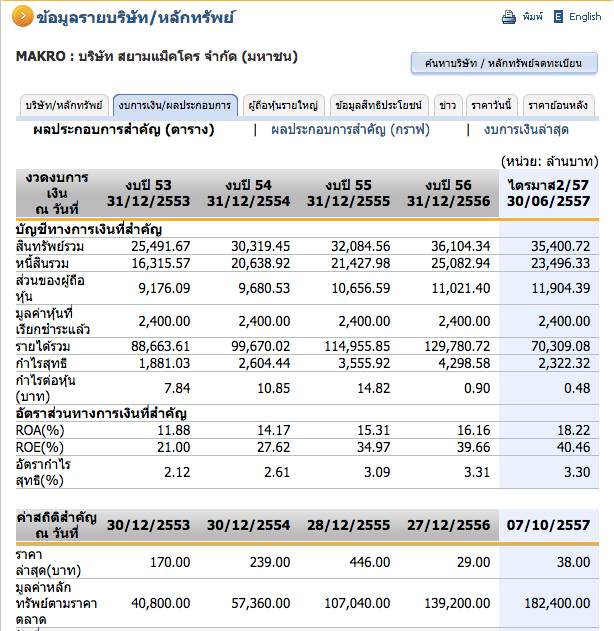Often times, people ask me, how come the Earnings per Share (EPS) of some of the stocks on Jitta is different from the value on set.or.th. The latest example was with the stock, MAKRO.

If you look at the information on SET, you will see that MAKRO’s EPS in the years 2010-2013 was 7.84, 10.85, 14.82, 0.9 respectively (see image).
While the information on the Jitta Factsheet 0.39, 0.54, 0.72, 0.9 (http://www.jitta.com/stock/bkk:makro/factsheet)
Why are the values completely different?
The reason is because in 2013, MAKRO has split its PAR: From 1 stock being valued at 10 Baht, to 20 stocks being valued at 0.5 Baht each.
Splitting the par does not have any affect on MAKRO’s business or its financial figures whatsoever. All it does is it increased MAKRO’s common shares from 240 million stocks to 4,800 million stocks, making all the figures that must be divided into “per share” different, because now we have to divide them by 4,800 instead of 240 million stocks.
The information on SET did not take this into account, which made it seem like the EPS greatly dropped from 14.82 in 2012 to 0.9 per Baht in 2013.
Seeing this, some people might think that the business is worsening, as the EPS figure has dropped (even though if you look at the net profit, you will see that it actually increased from over 3.5 billion Baht to over 4 billion Baht). This mistake will distort your analysis of the company.
This is why when Jitta receives information about any company splitting par, Jitta will alter all its ‘Per Share’ values, such as EPS, Dividend, etc. for all the years that Jitta has information in the Factsheet. We also recalculate the Jitta Score, Jitta Line, and many Jitta Fundamental values.
Personally, I feel like one of the things that makes the world of investing confusing is the par-splitting process. Because it confuses the people who have no understanding of the splitting-par process (for example, MAKRO’s price at 446 Baht fell to 29 Baht per share) or the “per Share” figures suddenly worsen (i.e. MAKRO from 14.85 Baht to 0.9 Baht)
So how do we know whether the company has split par or not?
It is actually very simple, and it is something that all investors should make a habit of when studying financial figures: looking at the real figures WITH the figures per share, together.
In the case of MAKRO, if we look at the net profit and the EPS on set.or.th, we will see the abnormality. The net profit increase, but the EPS decrease. We could try searching for news about how much the company split its par. Or we can just try dividing the net profit with EPS to find the number of stocks to see how much it increased.
From here, we can take the new number of stocks and divide it with the other financial figures to get the amount ‘per share’. This is a very tiring job, but it does get you the right per share values.
Jitta has built a system to fix the issues with the par-splitting, where we try to deliver the right information to the investors, so that they do not have to make the calculations themselves.
We would like to thank Kao Kung, one of our Jitta developers, who has helped developed this system throughout this entire year. Today, Jitta is one of the most updated platforms of information on stocks, especially when it comes to par-splitting.
